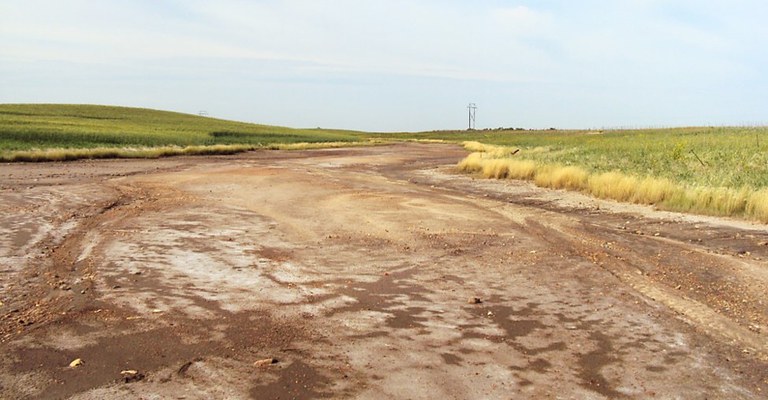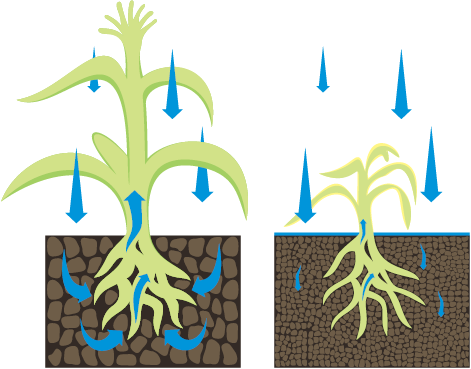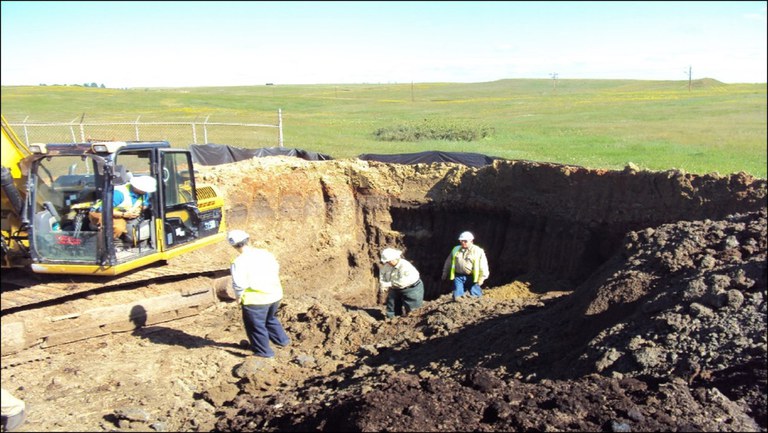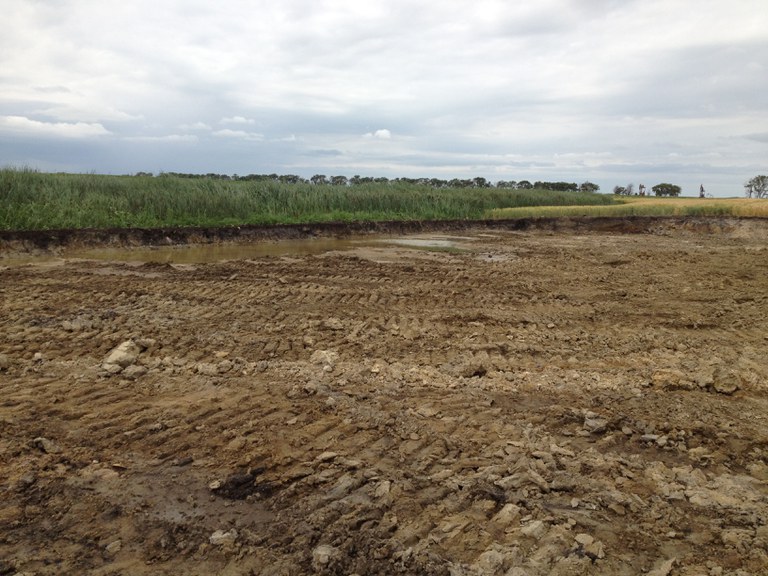Environmental Impacts of Brine (Produced Water) (R1850, June 2017)
Availability: Web only
A higher quantity of brine will need to be stored, transported and disposed of as the result of increased energy development. These larger quantities can lead to greater risks for spills. Brine spills negatively affect the soil and vegetation, impairing their ability to produce crops and forage (Figure 1).

Figure 1. This is a 50-year-old brine spill in northwestern North Dakota.
What is Brine?
Brine has a high salt concentration that has been recorded up to 10 times the salinity of ocean water. Brine solutions can have electrical conductivities (EC) in excess of 200 deciSiemens per meter (dS/m; 1 dS/m = 1 millimhos per centimeter [mmhos/cm]), sodium adsorption ratios (SAR) of more than 300 and total dissolved solids (TDS) concentrations of 100,000 parts per million.
The high salt concentrations in brine come from salt deposits in oil-producing formations, as seen in the Bakken and Three Forks formations in western North Dakota. However, the overall salinity and concentrations of sodium can vary widely by location and depth of extraction.

Figure 2. The average well in North Dakota produces 18 barrels of brine per barrel of oil and three barrels of brine per barrel of gas.
Brine Effects on Soil
The salts in brine alter the chemical and physical properties of soils. Due to the high amounts of soluble salts (predominately sodium chloride, NaCl), brine negatively impacts soils in many ways.
Chloride levels in and around the spill area are toxic to many biological species. Sodium is a natural dispersant and can cause soils to swell and disperse, but only if the total salt level in the soil falls below a flocculation threshold limit. A flocculant binds the soil together and helps create soil structure.
For most soils in the region, when the SAR from a saturated paste extract (assume that at values of less than 50, the SAR ≈ exchangeable sodium percentage ≈ % sodium) is 5 or more and the EC of the saturated paste is 2 dS/m or less, soils will swell and/or disperse (Figure 3). Thus, remediation strategies should focus on reducing the concentration of sodium (a known dispersant), increasing the concentration of calcium (a known flocculant), and maintaining EC levels above the threshold at which swelling and dispersion will occur.

Figure 3. Soil EC and sodium impact the structure of soils when swelling and dispersion occur, which impedes the ability of water to infiltrate through the soil.
Swelling soils will retain their natural structure, but soil structure will be lost once dispersion occurs. This loss of structure impedes the ability of water to infiltrate and move through the soil, increasing the potential for erosion.
Table 1. Relative Saline Tolerance Levels (EC) of Agronomic Crops1,2.
|
Crop |
EC (dS/m)Production Affected |
Upper Limit |
Tolerance Rating |
|
Canola |
10 |
14 |
High |
|
Barley |
8 |
16 |
High |
|
Wheat (durum) |
7 |
14 |
Moderate |
|
Wheat (semidwarf) |
7 |
14 |
Moderate |
|
Sugar beets |
7 |
14 |
Moderate |
|
Sunflowers |
6 |
14 |
Moderate |
|
Safflowers |
6 |
10 |
Moderate |
|
Oats |
4 |
8 |
Low |
|
Soybeans |
4 |
8 |
Low |
|
Alfalfa |
4 |
8 |
Low |
|
Corn |
3 |
6 |
Low |
|
Flax |
2 |
4 |
Low |
|
Edible beans |
1 |
2 |
Low |
1 Source: Ogle and St. John (2009).
2 Source: Franzen (2013).
Brine Effects on Vegetation
Salts in brine impair plants’ ability to take up water and nutrients. High salt concentrations in the soil restrict the plants’ ability to take up water despite adequate water being available in the soil, causing the plant to exhibit symptoms of drought. This is due to an osmotic effect, which causes water to move from areas of low salt concentrations, in the roots, to areas of high salt concentrations, in the soil.
Due to the impacts of high salt concentrations on soil and vegetation, impacted sites suffer from a decline in plant growth. This is magnified by the inability of many seeds to germinate. Under these conditions, seeds have difficulty taking up water, causing damage to the embryo or dormancy in response to water stress.
In addition to the inability to take up water, excess sodium and chloride ions can interfere with the plants’ ability to generate energy and reduce the uptake and/or use of key nutrients (Figure 4).

Figure 4. Effects of brine on vegetation.
Plants exposed to brine often die due to salt stress resulting from the inability to take up water and key nutrients. Most plants will show signs of salt stress if sodium exceeds 70 milligrams per liter in water, 5 percent in plant tissue or 230 milligrams per liter in soil (saturated paste extract).
Chloride negatively impacts most plants when it exceeds 350 milligrams per liter in water, 1 percent in plant tissue or 250 milligrams per liter in soil (saturated paste extract). However, some plant species are salt-tolerant; they are called halophytes.
Halophytes are able to grow and reproduce in soils with EC values of 20 dS/m or more. In comparison, EC values above 2 dS/m negatively affect the growth of many row crops and small grains. Halophyte plants are able to survive due to adaptations that allow them to regulate, transport or store salts safely in special compartments of the plants’ tissues.
Table 2. Relative Saline Tolerance Levels (EC) of Selected Range and Pasture Species1, 2.
|
EC (dS/m) Production Affected – Seedling Stage |
EC (dS/m) Production Affected – Vegetative Stage |
EC (dS/m) Plant Mortality |
Tolerance Rating |
Palatability |
|
|
Grass |
|||||
|
Nuttall’s alkaligrass |
8 |
14 |
32 |
Very high |
Medium |
|
Inland saltgrass |
12 |
16 |
32 |
Very high |
Medium |
|
Alkali sacaton |
10 |
32 |
32 |
Very high |
Medium |
|
Beardless wildrye |
13 |
26 |
Very high |
Medium |
|
|
Tall wheatgrass |
13 |
26 |
Very high |
Low |
|
|
Green wheatgrass (Newhy) |
13 |
26 |
Very high |
High |
|
|
Russian wildrye |
13 |
24 |
Very high |
Medium |
|
|
Alkali cordgrass |
12 |
24 |
Very high |
– |
|
|
Alkali bluegrass |
12 |
24 |
Very high |
– |
|
|
Slender wheatgrass |
10 |
22 |
Very high |
Medium |
|
|
Altai wildrye |
10 |
20 |
Very high |
Medium |
|
|
Plains bluegrass |
10 |
20 |
Very high |
Medium |
|
|
Tall fescue |
8 |
18 |
High |
Medium |
|
|
Western wheatgrass |
4 |
8 |
16 |
High |
High |
|
Crested wheatgrass |
6 |
14 |
Moderate |
High |
|
|
Intermediate wheatgrass |
6 |
12 |
Moderate |
High |
|
|
Little bluestem |
6 |
6 |
10 |
Moderate |
Medium |
|
Smooth brome |
5 |
10 |
Moderate |
Highest |
|
|
Meadow brome |
4 |
10 |
Moderate |
Highest |
|
|
Switchgrass |
– |
6 |
Low |
Medium |
|
|
Blue grama |
4 |
4 |
6 |
Low |
Highest |
|
Forbs and Shrubs |
|||||
|
Forage kochia |
10 |
18+ |
High |
Medium |
|
|
Fourwing saltbush |
10 |
18+ |
High |
Medium |
|
|
Winterfat |
10 |
18+ |
High |
High |
|
|
Strawberry clover |
6 |
16 |
High |
Highest |
|
|
Yellow sweetclover |
5 |
10 |
Moderate |
High |
|
|
Cicer milkvetch |
4 |
10 |
Moderate |
Highest |
|
|
Birdsfoot trefoil |
5 |
8 |
Low |
High |
|
|
Alfalfa |
4 |
8 |
Low |
Highest |
|
|
Clovers (red, alsike, ladino) |
3 |
4 |
Low |
Highest |
|
1 Source: Ogle and St. John (2009).
2 Source: Thomlinson, H. (2016).
Brine Spill Remediation
The goal of brine spill remediation is to remove or minimize salts in the soil, allowing for improved vegetation growth and establishment. Remediation can be accomplished through ex situ or in situ methods.
Ex Situ Remediation
Ex situ methods are most often utilized in North Dakota. During ex situ remediation, the topsoil or impacted depth is excavated from the site and moved to a landfill that is approved for the containment of oil-field wastes. New topsoil is brought in to replace the removed soil.
The new topsoil may have different chemical and physical properties, including a different seedbank, than the original soils. The new soil will not be contaminated with brine, but it should be managed to maintain a clean, weed-free seedbed for the reclamation process.

Figure 5. A crew is doing ex situ remediation of a brine spill.

Figure 6. The topsoil was removed from this spill site as part of ex situ remediation.
In Situ Remediation
In situ methods remove the salts from the topsoil while keeping the soil in place. The most commonly used methods include the application of chemical amendments, which can be supplemented with tile drainage.
Chemical amendments are used to replace sodium on the soil’s exchange sites, allowing the sodium to be leached lower in the soil profile, where it does not impact plant growth and establishment.
Chemical amendments are typically calcium-based, such as gypsum. Gypsum is the most commonly applied amendment used for in situ remediation in North Dakota.
However, the use of gypsum has limitations because it is only effective to the depth to which it is incorporated into the soil. In addition, the particle size of the gypsum being applied can influence reclamation. Smaller gypsum particles have greater surface area, causing it to react more quickly than larger particles.
The use of tile drainage aids in permanently removing the leached waters containing sodium and chloride to offsite disposal areas. However, one of the main limitations to successful remediation is applying enough water to 1) solubilize the gypsum so that calcium can counteract the negative effects of the sodium, and to maintain soil EC; 2) move calcium down the soil profile; and 3) leach the sodium and chloride into the tile and collection tanks, or below the rooting zone.
The success of in situ remediation can be enhanced through the establishment of halophytic vegetation. Halophytes take up salts and store them in plant parts. Harvesting the above-ground biomass and removing it from the site can reduce salts in the soil.
Remediation Results
Remediation is a long and costly process, often with limited success. However, new research and technologies have greatly improved the success of remediation projects. Important factors to consider when tackling a remediation project include:
- who is responsible for cleaning up the spill
- the extent of the impacted area
- the soil EC and SAR levels
- estimated cost of cleanup
- the desired land use
Answering these questions will help you determine the method(s) best suited for your site.
Following any remediation project, continuing to monitor the site to document the success of the project is important. Pay close attention to soil structure, EC and SAR levels, vegetation cover and production.
Citations
Energy and Environmental Research Center. 2016. North Dakota Remediation Resource Manual. University of North Dakota, Energy and Environmental Research Center, Grand Forks, N.D. 116 pp.
Franzen, D. 2013. Managing saline soils in North Dakota. Pub. SF1087 (Rev.), North Dakota State University Extension Service, Fargo. 12 pp.
Ogle, D., and L. St. John. 2009. Plants for saline to sodic soil conditions: TN Plant Materials No. 9A (Rev.). USDA, NRCS, October 2009.
Tanji, K.K., L. Rollins, P. Suyama and C. Farris. 2007. Salinity management guide. WateReuse Foundation, Alexandria, Va.
Thomlinson, H. 2016. Brine impacted soils in semiarid rangelands: greenhouse ED thresholds and ex situ/in situ remediation comparisons. North Dakota State University [MS thesis].
Funding for this publication was provided by USDA, NIFA Critical Agriculture Research and Extension Award 2016-69008-25092.

June 2017

